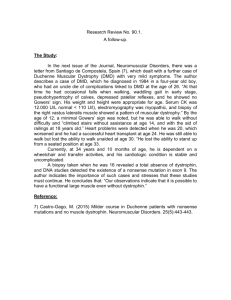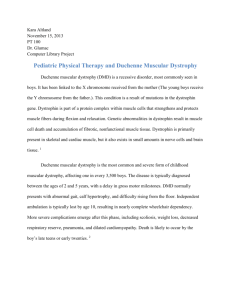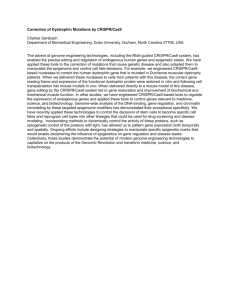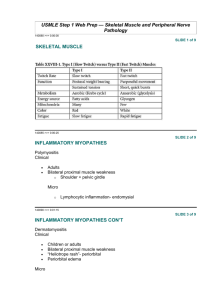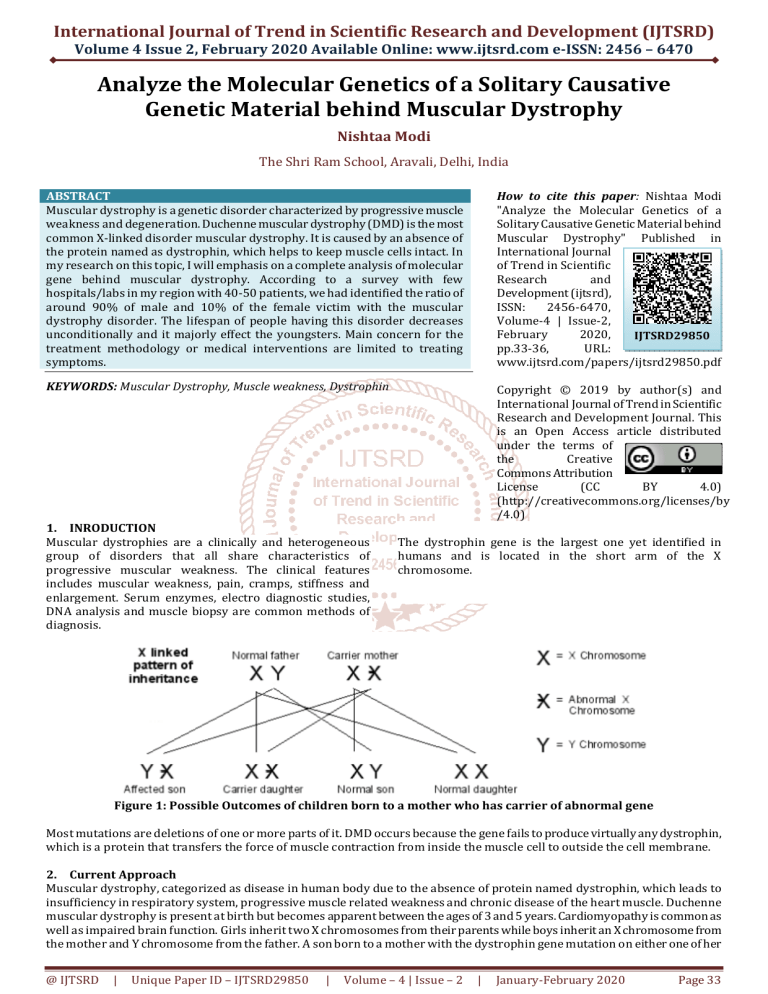
International Journal of Trend in Scientific Research and Development (IJTSRD)
Volume 4 Issue 2, February 2020 Available Online: www.ijtsrd.com e-ISSN: 2456 – 6470
Analyze the Molecular Genetics of a Solitary Causative
Genetic Material behind Muscular Dystrophy
Nishtaa Modi
The Shri Ram School, Aravali, Delhi, India
ABSTRACT
Muscular dystrophy is a genetic disorder characterized by progressive muscle
weakness and degeneration. Duchenne muscular dystrophy (DMD) is the most
common X-linked disorder muscular dystrophy. It is caused by an absence of
the protein named as dystrophin, which helps to keep muscle cells intact. In
my research on this topic, I will emphasis on a complete analysis of molecular
gene behind muscular dystrophy. According to a survey with few
hospitals/labs in my region with 40-50 patients, we had identified the ratio of
around 90% of male and 10% of the female victim with the muscular
dystrophy disorder. The lifespan of people having this disorder decreases
unconditionally and it majorly effect the youngsters. Main concern for the
treatment methodology or medical interventions are limited to treating
symptoms.
How to cite this paper: Nishtaa Modi
"Analyze the Molecular Genetics of a
Solitary Causative Genetic Material behind
Muscular Dystrophy" Published in
International Journal
of Trend in Scientific
Research
and
Development (ijtsrd),
ISSN:
2456-6470,
Volume-4 | Issue-2,
February
2020,
IJTSRD29850
pp.33-36,
URL:
www.ijtsrd.com/papers/ijtsrd29850.pdf
KEYWORDS: Muscular Dystrophy, Muscle weakness, Dystrophin
Copyright © 2019 by author(s) and
International Journal of Trend in Scientific
Research and Development Journal. This
is an Open Access article distributed
under the terms of
the
Creative
Commons Attribution
License
(CC
BY
4.0)
(http://creativecommons.org/licenses/by
/4.0)
1. INRODUCTION
Muscular dystrophies are a clinically and heterogeneous
group of disorders that all share characteristics of
progressive muscular weakness. The clinical features
includes muscular weakness, pain, cramps, stiffness and
enlargement. Serum enzymes, electro diagnostic studies,
DNA analysis and muscle biopsy are common methods of
diagnosis.
The dystrophin gene is the largest one yet identified in
humans and is located in the short arm of the X
chromosome.
Figure 1: Possible Outcomes of children born to a mother who has carrier of abnormal gene
Most mutations are deletions of one or more parts of it. DMD occurs because the gene fails to produce virtually any dystrophin,
which is a protein that transfers the force of muscle contraction from inside the muscle cell to outside the cell membrane.
2. Current Approach
Muscular dystrophy, categorized as disease in human body due to the absence of protein named dystrophin, which leads to
insufficiency in respiratory system, progressive muscle related weakness and chronic disease of the heart muscle. Duchenne
muscular dystrophy is present at birth but becomes apparent between the ages of 3 and 5 years. Cardiomyopathy is common as
well as impaired brain function. Girls inherit two X chromosomes from their parents while boys inherit an X chromosome from
the mother and Y chromosome from the father. A son born to a mother with the dystrophin gene mutation on either one of her
@ IJTSRD
|
Unique Paper ID – IJTSRD29850
|
Volume – 4 | Issue – 2
|
January-February 2020
Page 33
International Journal of Trend in Scientific Research and Development (IJTSRD) @ www.ijtsrd.com eISSN: 2456-6470
X chromosomes has a 50% chance of having DMD. While the daughter has a 50% chance of inheriting the mutation and being a
carrier. Typically, women are carriers while the disease observed in males. A man suffering with DMD cannot pass the disease
on to his son because he provides the Y chromosome that is free of the gene and the mutation but he can pass of the mutation to
his daughter making her a carrier and putting her progeny (MALE) at risk.
At present corticosteroids are the only pharmacologic agents with proved benefits even though they are associated with
several adverse effects like gastrointestinal symptoms and weight gain. Mutation suppression, cell therapy, gene therapy,
utrophin modulation etc. offer potential solutions. Yet an absolute cure is yet to found. Serum aldolase test indicates muscle
degeneration and a definite aid in distinguishing primary myopathy from secondary or neurogenic muscle atrophy.
Demography
Levels of enzymes
Age
9 years
Sex
Male
CK
7476 U/L (NV= 150 to 499 U/L)
Aldolase
23.94 U/L (1 to 7.6 U/L)
Figure1: Levels of CK and Aldolase
Currently, treatment of Duchenne muscular dystrophy includes the use of corticosteroids that delay the progression of the
disease; increase muscle strength and walking time as well reduce the progression of respiratory malfunction, cardiomyopathy
and scoliosis. However, a cure has not found yet. A possible cure that explored by researchers is a gene therapy that would
involve the insertion of the dystrophin gene through a vector. This has proven to be effective in animals like mice and dogs, but
it’s not tested on humans.
Working of CRISPR/CAS9 – This method of genetic therapy relies on bacteria’s ability to defend itself against viral infection,
which is similar to an immune system response. When the bacteria detects foreign DNA the CRISPR protein inserts a piece of this
DNA into the bacteria’s own genome. Therefore, the bacteria is able to recognize this DNA and protect itself from future viral
attacks.
Figure 2: How CRISPR works
This technique is perform by producing antibodies that consist of two kinds of short RNA, one of which contains a sequence
matching the viral DNA. These two short RNA form a complex with the protein called cas9, which is a nuclease capable of
“cutting” DNA. The matching sequence, called as “guide RNA” and it leads the complex to the viral genome so the CAS9 can cut the
viral DNA and prevent further replication and spread of the viral infection.
Using CRISPR to address Muscular Dystrophy – Duchenne muscular dystrophy is an X linked disorder, which caused due to
various kinds of mutations in the DMD gene that enables cells to produce dystrophin that is a protein, which gives muscles
strength and protects them from damage during contraction and relaxation. The technology uses CRISPR-CAS9 method to cut
the mutated part of the DMD gene and allows to the cell’s natural healing mechanism to repair and reform the healthy parts of
the gene so a shortened but healthy version enabled to produce sufficient dystrophin protein. The mutation once corrected in
muscle stem cells will ensure that the cells regenerated from cured cells will be healthy and free of the mutation. This geneediting tool delivered to Mice through a viral vector known as AAV9. The transplanted muscle died first and then regenerated
from it stem cells, which carried the edited gene. A clinical trial using the technology on dogs also provided promising results
3. Proposed Scope
Potential challenges – immune response against CAS9. The two most common sources of CAS9 are staphylococcus aureus and
streptococcus pyogenes, which are common disease causing agents in humans. Approximately 80% humans proposed to
exposed and thus, contain anti-CAS9 antibodies, which creates a threat of immune response against CAS9. The implications of
this on gene therapy depends on the kind of editing. In ex vivo gene therapy cells treated in a dish prior to transplantation so
immune response can prevented by using transient cas9 expression and waiting for the cas9 protein to clear before
administering the corrected cells to patients. In vivo editing, on the other hand leads to long-term gene expression in the
presence of a fully functional immune system. The most basic solution is to increase the efficiency of the viral vector used to
administer the cas9 protein so that the amount of the administered vector can reduced. Other solutions include capsid
modifications, improvement of transgene expression, avoiding expression in APCs, (sub) gene therapy in the brain etc.
@ IJTSRD
|
Unique Paper ID – IJTSRD29850
|
Volume – 4 | Issue – 2
|
January-February 2020
Page 34
International Journal of Trend in Scientific Research and Development (IJTSRD) @ www.ijtsrd.com eISSN: 2456-6470
Age 6 Months
Age 12 Months
Affected
Normal
Affected
Normal
range
range
range
range
Tetanic flexion (Newton/kg)
0.438-0.794 1.23-1.48
0.402-1.08
1.26 -1.65
Tetanic extension (Newton/kg)
0.366-2.07
2.00-3.20
1.34-2.54
1.98 - 2.65
Tibiotarsal joint angle (degrees)
140-160
158-162
130-155
149 - 158
% Eccentric contraction decrement (@ 10 stims).
8.10-40.7
8.22-11.9
29.5-59.0
3.47 - 12.3
% Eccentric contraction decrement (@ 30 stims).
29.7-74.8
17.2-24.7
64.1-72.6
7.59 - 20.1
Maximum hip flexion angle
45-105
56-80
42-100
52 - 70
Pelvic angle
36-57
25-40
44-54
37 - 50
Cranial sartorius circumference (mm/kg)
3.00-5.10
2.16-2.74
4.62-4.62
2.17 - 2.34
Quadriceps femoris weight (g)
79.5-110
172-223
98.3-120.2
203 - 258
Quadriceps femoris weight (g/kg body weight)
6.65-8.27
9.20-12.7
8.19-8.86
8.99 - 10.8
Figure 3: Range for muscular dystrophy and its affected range in infants
Figure 4: Histopathology of Duchenne muscular dystrophy (DMD)
A team led by Eric Olson at the University of Texas Southwestern Medical Center used CRISPR/cas9 technology to reverse the
mutation responsible for Duchenne muscular dystrophy. DMD isn’t the most obvious choice for CRISPR’s find , cut and replace
function because the dystrophin gene is the largest in the human genome, and the same disease can be caused by a multitude of
different mutations. But Olson found a way to target a common error spot on exon 51, which he figured could, with a single
slice, benefit approximately 13 percent of DMD patients.
This experiment followed previous work on mice and human heart cells. The CRISPR gene editing component was attached to a
virus that has a strong affinity for muscle cells. This was then injected into community of four one month old beagles. One group
of two dogs was given a shot directly in the lower leg and the second group was given an intravenous infusion. After eight
weeks, CRISPR had restored dystrophin levels in the second group to more than 50 percent of normal in the legs, and more
than 90 percent in the heart. According to the researchers, restoring even unto 15% of the dystrophin protein levels of the body
could have a significant impact and could even prove to be curative. Another reason that this trial was a breakthrough because
CRISPR was used body wide on a large mammal for the first time especially to address a fatal disorder of a large magnitude.
“They showed obvious signs of behavioural improvement—running, jumping—it was quite dramatic,” says Olson, but he did
not make note of these qualitative observations on record because the sample size for the trial was extremely small.
Fig 5: Experimental analysis of bicep muscles to check restored dystrophin level
The restored dystrophin levels (green) in the bicep muscles of a healthy dog (first panel fro left), an untreated dog (second
panel from left), and dogs treated with low (third panel from left) and high (fourth panel from left) intravenous dose of CRISPR
gene editing technology.
@ IJTSRD
|
Unique Paper ID – IJTSRD29850
|
Volume – 4 | Issue – 2
|
January-February 2020
Page 35
International Journal of Trend in Scientific Research and Development (IJTSRD) @ www.ijtsrd.com eISSN: 2456-6470
CRISPR technology had been used before to restore
dystrophin expression in mice suffering from Duchenne
muscular dystrophy. In order to test it further a larger
mammal had to be used. Dogs with DMD offer something
mouse models can’t – they display many similar symptoms
to humans affected by DMD, such as muscle weakness and
wasting.
Although the results of the study were extremely promising
to the effect that this technology can be used as a potential
cure for humans it has to be taken into account that the
sample size was extremely small (4 dogs) and the duration of
observation was also very limited. In order to fully
understand the implications of using the CRISPR gene
editing tool a study of a longer observation time and larger
sample must be conducted.
“Viruses are promising and effective tools for gene therapy,
but there are potential dangers. Using even a harmless virus
for gene therapy could result in a life-threatening immune
response against the virus,” said Jason Nomburg, a virology
graduate student at Harvard University. “This is especially
true when the virus is administered systemically to the
blood at high concentration, like in this study. A second
injection can be especially dangerous because it has even
greater potential to provoke an immune response. Without
knowing how durable the treatment is long-term, this might
be a one-time shot.”
Another major concern is safety because the gene editing
technology may have “ off target effects” in that it may affect
unwanted sites. fortunately, that didn’t happen in this
particular study.
4. CONCLUSION
Duchenne muscular dystrophy is a genetic disorder that is
characterised by progressive muscular weakness due to
disrupted production of the protein dystrophin that is
responsible for keeping muscle cells intact and ensures their
smooth functioning. The symptoms are usually observed in
early childhood, around 2-3 years, and is generally observed
in boys because its an X-linked disease. Currently,
corticosteroid therapy is the only pharmacological method to
address the problem, however, there is only an impact on
symptoms and it is not curative. CRISPR/cas9 gene editing
technology is an interesting avenue in this regard because of
its potential for permanent exon skipping leading to the
capacity for dystrophin restoration which might even lead to
normal muscle functioning. The aim of gene replacement is to
substitute the diseased dystrophin creating gene with a
healthy one. The primary challenge is to determine the safe
and effective methods to deliver this healthy replacement
dystrophin or dystrophin - like gene to muscles body wide.
This is because currently viral vector mediated gene
replacement is being explore which poses the threat of an
immune response by the body of the patient. Research needs
to be focused mainly on targeted delivery and long term
expression of the healthy gene. But the relatively successful
clinical trials with dogs and mice do provide hope that gene
replacement and editing may actually hold a permanent cure
to this fatal disease.
Few questions framed by Nishtaa Modi as part of her market
research with medical practitioners. Below responses she got
while interviwing the same.
@ IJTSRD
|
Unique Paper ID – IJTSRD29850
|
[Nishtaa]: Have you ever seen patients having muscular
dystrophy symptoms?
[Doctor]: Yes, we had seen many patients with muscular
dystrophy symptom
[Nishtaa]: What was the age group of people
[Doctor]: From 6 months old kid to 60+ years old citizen.
[Nishtaa]: Which enzyme is responsible for this?
[Doctor]: It is caused because of lack of dystrophin protein in
body
[Nishtaa]: Any specific symptoms?
[Doctor]: Progressive weakness, loss of muscle mass,
difficulty in walking and later on swallowing
[Nishtaa]: Is that curable, if yes explanations
[Doctor]: Yes, with proper medications as well as exercise.
[Nishtaa]: If not curable, any manual exercise suggested
[Doctor]: Genetic therapy can have scope. And, Physical
theraphy can improve quality of life
[Nishtaa]: Drug suggested for improvement of disease?
[Doctor]: Corticosteroids like Prednisone
DECLARATION OF PATIENT CONSENT
The authors certify that they have obtained all appropriate
patient consent forms. In the form the patient(s) has/have
given his/her/their consent for his/her/their images and
other clinical information to be reported in the journal. The
patients understand that their names and initials will not be
published and due efforts will be made to conceal their
identity, but anonymity cannot be guaranteed.
REFERENCES:
[1] Online article from healthline.com
[2] Brown RH Jr,Hoffman EP, Kunkel LM. Article on
Dystrophin: The protein product of the Duchenne
muscular dystrophy locus. Cell 1987;51:919-28.
[3] Robb SA, Ricotti V, Ridout DA, Manzur AY, Scott E,
Quinlivan R, et al. Long-term benefits and adverse
effects of intermittent versus daily glucocorticoids in
boys with Duchenne muscular dystrophy. J Neurol
Neurosurg Psychiatry
[4] Bibliometric analysis of main research areas through
KeyWords Plus.Cantos et al. Stem cell research. Aslib
Proceedings
[5] Global stem cell research trend: Bibliometric analysis
as a tool for mapping of trends from 1991 to 2006, by
Li LL, Ding G, Feng N, Wang MH, Ho YS.
[6] Assessing stem cell research productivity.
Scientometrics 2003, By Ho YS, Chiu CH, Tseng TM,
Chiu WT.
[7] Reports on experiments performed by Eric Olson at the
University of Texas at Southwestern Medical Center
using CRISPR/cas9
AUTHOR:
Nishtaa Modi is a student of
grade 11 studying in the Shri
Ram School Aravali. She
intends to pursue higher
studies in biochemistry and
genetics. She plays the Sitar
and is an avid debater. She
hopes that some day she can
make her passion for biology and chemistry her profession.
Volume – 4 | Issue – 2
|
January-February 2020
Page 36

